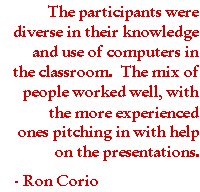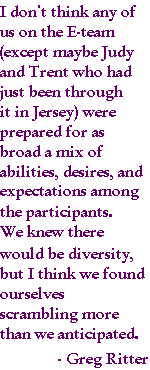
At Newark, there were 36 participants, mostly from campuses in the NY/NJ area, but some from as far away as Wisconsin and California; half a dozen lacked e-mail addresses, about twice that many had well-established homepages, and the others ranged between these extremes of access and expertise.
 Bringing together around 100 academics for long workshops on integrating computer technology
with the teaching of writing and literature raised a host of issues that ordinarily do not confront
the average professor toiling away in the solitude of his or her own institution. But the Epiphany
Project, and especially the summer institutes, are specifically designed to encourage
collaboration between institutions. The institutional diversity participants brought to both
Newark and Richmond highlighted the problems of faculty development through multiple voices and from multiple
angles. Some spoke of technological problems, but all were moved when, at the end of the
institute, Ann Woolford-Singh reminded everyone that issues of
gender, class and power cut across institutional lines, and are critical in the male-dominated,
costly, and sometimes difficult-to-grasp world of the technologically enhanced classroom.
Bringing together around 100 academics for long workshops on integrating computer technology
with the teaching of writing and literature raised a host of issues that ordinarily do not confront
the average professor toiling away in the solitude of his or her own institution. But the Epiphany
Project, and especially the summer institutes, are specifically designed to encourage
collaboration between institutions. The institutional diversity participants brought to both
Newark and Richmond highlighted the problems of faculty development through multiple voices and from multiple
angles. Some spoke of technological problems, but all were moved when, at the end of the
institute, Ann Woolford-Singh reminded everyone that issues of
gender, class and power cut across institutional lines, and are critical in the male-dominated,
costly, and sometimes difficult-to-grasp world of the technologically enhanced classroom.
 In trying to describe what one person does at her home institution, or what might happen if a
software package or instructional technique were brought there, participants were forced to
consider the wide institutional diversity that constitutes American higher education.
In trying to describe what one person does at her home institution, or what might happen if a
software package or instructional technique were brought there, participants were forced to
consider the wide institutional diversity that constitutes American higher education.
We came from schools as remote as Barrow, Alaska and Presque Isle, Maine, and as urban as New York, New York.. Some participants were computer professionals, and others were lifelong teachers of literature who had yet to learn how to use the mouse.
Although we had diverse groups with divergent skills and interests, there were still points of
agreement on fundamental issues that are at the heart of the Epiphany Project.
Even with the natural linkages of interest and participation, when participants reflected back on
the Newark experience via the Epiphany listserv, and when the Richmond participants split into
small groups, a touchstone of the Project hit home: when
training people to use technology, the most important questions revolve not around bits and bytes
but around students and teachers:
What do I wish to teach? Why? How? And
to whom?
Judy Williamson summed up this diversity of participants best when she wrote:
I think this is a strength for the program, and a very fundamental one at that. I will stand by my
claim that everyone brings something unique to offer to a group, and although some of us are farther along the technological highway than others, I found myself
learning from folks regardless of technological skill level. The learning happened, again, due to
a shared dynamic which makes me want to stand by the Project's fundamental belief in
collaboration and group work.
| Formats | Themes | Leaders | People |
Send comments about this page to: Claudine Keenan
![]()